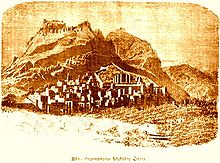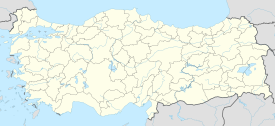61:
54:
38:
336:, cisterns, and residential buildings are carefully adapted into the folds of the lofty outcrop of limestone. The vast majority of these constructions are built with well-cut rusticated ashlar, a masonry typical of Armenian fortifications. There are fragments of
273:, a Teutonic monk who visited Sis in 1212, found a complete and well-established capital. Het‛um's wife, Zapēl, is credited with building a hospital there in 1241. A fragment of a dedicatory inscription still in situ within the castle mentions "Het‛um".
359:
Directly below the castle outcrop at the southeast is a large terrace which has the remains of several important churches and chapels in the
Compound of the Patriarchs, including the basilica of St. Sophia, built by
316:
They burned the town of Sis, which was the seat of the
Armenian kings. They cast wood into the fire and great church which was the center of Sis and they burned it. They demolished the tombs of the kings.
286:, Sis became the Catholicos' residence. In 1266 the Mamluks looted and burnt the city. In 1275 the Mamluks again surrounded the city, but were defeated by Armenian forces. A century later, in 1369 the
528:
364:, and the 18th-century church of St. Gregory the Illuminator. One of the chapels, Kara Kilise, still preserves the apse and the pointed vault over the nave.
521:
514:
668:
678:
101:
53:
673:
414:
219:
Secunda. The names Sisan or Sisia are first mentioned in the 5th and 6th centuries in Greek and Latin sources. In 703–04 A.D., the
537:
565:
378:
298:
255:
181:
332:. If laid from end to end, the circuit walls would measure almost 3 kilometers in length. The walls, towers, vaulted
613:
361:
261:
From the late 12th through the 13th centuries, the castle was significantly enlarged during the reigns of King
216:
337:
484:
Robert W. Edwards, "Ecclesiastical
Architecture in the Fortifications of Armenian Cilicia: Second Report,"
409:. Washington, D.C.: Dumbarton Oaks, Trustees for Harvard University. pp. 233–237, 285, pls.211a-221a.
605:
557:
471:
Robert W. Edwards, "Ecclesiastical
Architecture in the Fortifications of Armenian Cilicia: First Report,"
270:
262:
243:
215:
During the 1st century B.C. Sis appears to have been an unfortified village in the Roman province of
597:
353:
325:
continued to inhabit the town where several late medieval residential structures were preserved.
322:
17:
410:
228:
173:
341:
309:
302:
291:
287:
283:
276:
448:. University Center for International Studies, University of Pittsburgh. 1976. p. 44.
184:. The massive fortified complex is just to the southwest of the modern Turkish town of
348:. Because of its strategic location, Sis has indivisibility with the castles at Andıl,
227:
attack, but were soon forced to abandon the town, which became a frontier post for the
205:
189:
85:
662:
235:
209:
266:
589:
581:
373:
185:
81:
297:, looted and burnt it, and captured the king and many lords. With Sis fallen, the
506:
432:
Colophons of
Armenian Manuscripts, 1301-1408: A Source for Middle Eastern History
294:
333:
116:
103:
349:
340:
as well as an entrance corridor at the southeast which was built during the
251:
239:
220:
145:
573:
290:
again conquered the city, but were forced to leave. Finally, in 1375 the
201:
141:
645:
502:
Carefully documented photographic survey and plan of Sis Castle / Kozan
434:. Cambridge, Massachusetts: Harvard U.P. pp. 92, 95, 99, 111, 294.
247:
37:
549:
345:
329:
232:
89:
501:
407:
458:
Robert W. Edwards, "Settlements and
Toponymy in Armenian Cilicia,"
280:
621:
224:
510:
328:
The castle at Sis is one of the largest fortified sites in the
269:
with a "palace," residential buildings, churches, and gardens.
629:
254:
possession in 1113, when it was occupied by
Rubenid Baron
242:
defenses in the mid-9th century. The
Byzantine Emperor
159:
151:
137:
132:
95:
76:
446:Byzantine studies: Études byzantines: Volumes 3-4
301:also fell and its territory was annexed into the
314:
200:In the 3rd millennium B.C. Sis was one of the
522:
8:
42:The fortress in the old Armenian Capital Sis
30:
529:
515:
507:
60:
36:
29:
400:
398:
396:
394:
390:
344:occupation and has an inscription in
7:
25:
18:Sis (Armenian Kingdom of Cilicia)
488:37, 1983, pp.134-141, pls.47-67.
475:36, 1982, pp.168-170, pls.24-30.
59:
52:
246:recaptured Sis in 962 from the
538:Historical capitals of Armenia
208:between the mountains and the
1:
577:(176–177 BC and 69 BC–120 AD)
460:Revue des Études Arméniennes
250:, only to have it become an
669:Armenian Kingdom of Cilicia
405:Edwards, Robert W. (1987).
379:Armenian Kingdom of Cilicia
299:Armenian Kingdom of Cilicia
277:After Hromkla was conquered
182:Armenian Kingdom of Cilicia
695:
679:Former capitals of Armenia
544:
180:) was the capital of the
177:
47:
35:
674:6th century BC in Greece
430:Sanjian, Avedis (1969).
80:Near the modern town of
323:20th century Armenians
319:
271:Wilbrand von Oldenburg
486:Dumbarton Oaks Papers
473:Dumbarton Oaks Papers
223:settlers repulsed an
117:37.44444°N 35.81028°E
27:Ancient Armenian city
462:24, 1993, pp.201-03.
244:Nikephoros II Phokas
204:settlements on the
113: /
68:Shown within Turkey
32:
238:reconstructed the
122:37.44444; 35.81028
656:
655:
229:Abbasid Caliphate
167:
166:
155:3rd millennium BC
16:(Redirected from
686:
531:
524:
517:
508:
489:
482:
476:
469:
463:
456:
450:
449:
442:
436:
435:
427:
421:
420:
402:
310:Gregory of Akner
303:Mamluk Sultanate
179:
128:
127:
125:
124:
123:
118:
114:
111:
110:
109:
106:
63:
62:
56:
40:
33:
21:
694:
693:
689:
688:
687:
685:
684:
683:
659:
658:
657:
652:
540:
535:
498:
493:
492:
483:
479:
470:
466:
457:
453:
444:
443:
439:
429:
428:
424:
417:
404:
403:
392:
387:
370:
338:Byzantine walls
321:Into the early
198:
121:
119:
115:
112:
107:
104:
102:
100:
99:
72:
71:
70:
69:
66:
65:
64:
43:
28:
23:
22:
15:
12:
11:
5:
692:
690:
682:
681:
676:
671:
661:
660:
654:
653:
651:
650:
642:
634:
626:
618:
610:
602:
594:
586:
578:
570:
562:
554:
545:
542:
541:
536:
534:
533:
526:
519:
511:
505:
504:
497:
496:External links
494:
491:
490:
477:
464:
451:
437:
422:
415:
389:
388:
386:
383:
382:
381:
376:
369:
366:
258:and repaired.
206:Cilician plain
197:
194:
190:Adana Province
165:
164:
161:
157:
156:
153:
149:
148:
139:
135:
134:
130:
129:
97:
93:
92:
86:Adana Province
78:
74:
73:
67:
58:
57:
51:
50:
49:
48:
45:
44:
41:
26:
24:
14:
13:
10:
9:
6:
4:
3:
2:
691:
680:
677:
675:
672:
670:
667:
666:
664:
648:
647:
643:
640:
639:
635:
632:
631:
627:
624:
623:
619:
616:
615:
611:
608:
607:
603:
600:
599:
595:
592:
591:
587:
584:
583:
579:
576:
575:
571:
568:
567:
566:Yervandashat
563:
560:
559:
555:
552:
551:
547:
546:
543:
539:
532:
527:
525:
520:
518:
513:
512:
509:
503:
500:
499:
495:
487:
481:
478:
474:
468:
465:
461:
455:
452:
447:
441:
438:
433:
426:
423:
418:
416:0-88402-163-7
412:
408:
401:
399:
397:
395:
391:
384:
380:
377:
375:
372:
371:
367:
365:
363:
362:King Het‛um I
357:
355:
351:
347:
343:
339:
335:
331:
326:
324:
318:
313:
311:
308:According to
306:
304:
300:
296:
295:took the city
293:
289:
285:
282:
278:
274:
272:
268:
264:
259:
257:
253:
249:
245:
241:
237:
236:Al-Mutawakkil
234:
230:
226:
222:
218:
213:
211:
210:Mediterranean
207:
203:
195:
193:
191:
187:
183:
175:
171:
162:
158:
154:
150:
147:
143:
140:
136:
131:
126:
98:
94:
91:
87:
83:
79:
75:
55:
46:
39:
34:
19:
649:(since 1918)
644:
637:
636:
628:
620:
612:
604:
596:
590:Vagharshapat
588:
580:
572:
569:(210–176 BC)
564:
561:(331–210 BC)
556:
553:(832–590 BC)
548:
485:
480:
472:
467:
459:
454:
445:
440:
431:
425:
406:
374:Kozan, Adana
358:
327:
320:
315:
307:
275:
260:
214:
199:
169:
168:
641:(1080–1375)
582:Tigranakert
334:undercrofts
120: /
96:Coordinates
663:Categories
633:(961–1045)
614:Shirakavan
585:(77–69 BC)
385:References
108:35°48′37″E
105:37°26′40″N
625:(929–961)
617:(890–929)
609:(885–890)
601:(336–428)
593:(120–330)
350:Anazarbus
265:and King
240:Byzantine
221:Byzantine
160:Abandoned
146:Armenians
574:Artashat
558:Armavir
368:See also
281:Egyptian
267:Het‛um I
256:T‛oros I
252:Armenian
248:Abbasids
174:Armenian
142:Hittites
77:Location
646:Yerevan
606:Bagaran
292:Mamluks
288:Mamluks
284:Mamluks
279:by the
263:Levon I
217:Cilicia
212:coast.
202:Hittite
196:History
152:Founded
138:Builder
133:History
550:Tushpa
413:
352:, and
346:Arabic
342:Mamluk
330:Levant
233:Caliph
231:. The
90:Turkey
354:Tumlu
186:Kozan
82:Kozan
622:Kars
598:Dvin
411:ISBN
225:Arab
163:1921
144:And
638:Sis
630:Ani
188:in
178:Սիս
170:Sis
31:Sis
665::
393:^
356:.
312:,
305:.
192:.
176::
88:,
84:,
530:e
523:t
516:v
419:.
172:(
20:)
Text is available under the Creative Commons Attribution-ShareAlike License. Additional terms may apply.

